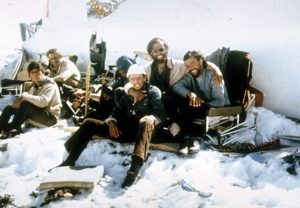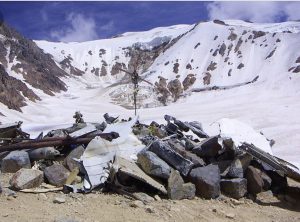corpse
 On October 13, 1972 a plane crashed somewhere in the Andes Mountains. That isn’t such an unusual event, but the crash was the last part of this event that was not unusual. Flight 571 was en route from Uruguay to Chili at the time it went down. The Uruguayan Air Force plane was chartered by the Old Christians Club to transport the team from Montevideo, Uruguay to Santiago, Chile. On October 12 the twin-engined Fairchild turboprop left Carrasco International Airport. The plane was carrying 5 crew members and 40 passengers. In addition to club members…friends, family, and others were also on board, having been recruited to help pay the cost of the plane. Because of poor weather in the mountains, they were forced to stay overnight in Mendoza, Argentina, before departing at about 2:18 pm the following day, October 13th. Although Santiago was located to the west of Mendoza, the Fairchild was not built to fly higher than approximately 22,500 feet. Because the Andes mountains were higher than that, the pilots plotted a course south to the Pass of Planchón, where the aircraft could safely clear the Andes mountains. An hour after takeoff, the pilot notified air controllers that he was flying over the pass, and shortly thereafter he radioed that he had reached Curicó, Chile, some 110 miles south of Santiago, and had turned north. However, the pilot had misjudged the location of the aircraft, which was still in the Andes mountains. Unaware of the mistake, the controllers cleared him to begin descending in preparation for landing. Then suddenly, the Chilean control tower was unable to contact the plane.
On October 13, 1972 a plane crashed somewhere in the Andes Mountains. That isn’t such an unusual event, but the crash was the last part of this event that was not unusual. Flight 571 was en route from Uruguay to Chili at the time it went down. The Uruguayan Air Force plane was chartered by the Old Christians Club to transport the team from Montevideo, Uruguay to Santiago, Chile. On October 12 the twin-engined Fairchild turboprop left Carrasco International Airport. The plane was carrying 5 crew members and 40 passengers. In addition to club members…friends, family, and others were also on board, having been recruited to help pay the cost of the plane. Because of poor weather in the mountains, they were forced to stay overnight in Mendoza, Argentina, before departing at about 2:18 pm the following day, October 13th. Although Santiago was located to the west of Mendoza, the Fairchild was not built to fly higher than approximately 22,500 feet. Because the Andes mountains were higher than that, the pilots plotted a course south to the Pass of Planchón, where the aircraft could safely clear the Andes mountains. An hour after takeoff, the pilot notified air controllers that he was flying over the pass, and shortly thereafter he radioed that he had reached Curicó, Chile, some 110 miles south of Santiago, and had turned north. However, the pilot had misjudged the location of the aircraft, which was still in the Andes mountains. Unaware of the mistake, the controllers cleared him to begin descending in preparation for landing. Then suddenly, the Chilean control tower was unable to contact the plane.
The pilot basically found himself caught with high mountains all around him…mountains that he could not climb over. When the plane tried to climb out the wings were clipped by the peaks, and the plane crashed in an unknown location. Because the Chilean control tower thought the plane was much further south, they weren’t even sure where to look. To make matters worse, the white plane was extremely difficult to see against the white snow. Search and rescue efforts from the sky were almost impossible…despite the survivors’ attempts to become noticeable. After 11 days, it was assumed that all of the 45 passengers and crew were dead, so search and rescue efforts ceased. The passengers had access to a radio, and when they heard the news of the search  being called off, they were devastated. The crash killed 12 people instantly, leaving 33 survivors to try to stay alive until help could come. A number of the survivors were injured. At an altitude of approximately 11,500 feet, the group faced snow and freezing temperatures. There was no heat, and they only had each other to depend on. While the plane’s fuselage was largely intact, it provided limited protection from the freezing temperatures they faced. Food was scarce…mainly candy bars and wine. Even with rationing, those were gone in about a week. Now the survivors faced the most horrifying decision of their lives. Do they stay alive at all costs, including eating the bodies of the dead for food, or do they simply give up and starve to death? After a heated discussion, the starving survivors resorted to eating the corpses. Their survival instincts had kicked in, even though they knew they might be condemned by the world. Nevertheless, they would probably never forgive themselves anyway, so what the world decided made no real difference. Over the next few weeks six others died, and further disaster struck on October 29, when an avalanche buried the fuselage and filled part of it with snow, causing eight more deaths.
being called off, they were devastated. The crash killed 12 people instantly, leaving 33 survivors to try to stay alive until help could come. A number of the survivors were injured. At an altitude of approximately 11,500 feet, the group faced snow and freezing temperatures. There was no heat, and they only had each other to depend on. While the plane’s fuselage was largely intact, it provided limited protection from the freezing temperatures they faced. Food was scarce…mainly candy bars and wine. Even with rationing, those were gone in about a week. Now the survivors faced the most horrifying decision of their lives. Do they stay alive at all costs, including eating the bodies of the dead for food, or do they simply give up and starve to death? After a heated discussion, the starving survivors resorted to eating the corpses. Their survival instincts had kicked in, even though they knew they might be condemned by the world. Nevertheless, they would probably never forgive themselves anyway, so what the world decided made no real difference. Over the next few weeks six others died, and further disaster struck on October 29, when an avalanche buried the fuselage and filled part of it with snow, causing eight more deaths.
It was decided that someone would have to walk out and tell the officials that they were still alive. On December 12, with just 16 people still alive, three passengers set out for a 10 day journey to find help, though one later returned to the wreckage. After a difficult trek, the other two men finally came across three herdsmen in the village of Los Maitenes, Chile, on December 20. However, the Chileans were on the opposite side of a river, the noise of which made it hard to hear. The herdsmen indicated that they would return the following day. Early the next morning, the Chileans reappeared, and the two groups communicated by writing notes on paper that they then wrapped around a rock and threw across the water. The survivors’ initial note began, “I come from a plane that fell in the mountains.” The Chileans must have heard about the crash, and were most likely stunned to find that there were actually survivors. They hurried to notified authorities, and on December 22 two helicopters were sent to the wreckage. Six survivors were flown to safety, but bad weather delayed the eight others from being rescued until the next day. The  rescue was called the Miracle of the Andes. In the resulting media frenzy, the survivors revealed that they had been forced to commit cannibalism. Many people were outraged until one of the survivors claimed that they had been inspired by the Last Supper, in which Jesus gave his disciples bread and wine that he stated were his body and his blood. This helped soften public opinion, and the church later absolved the men. After watching the movie based on this event, I wondered how any of the rest of us would have handled that situation. We should never be too quick to judge people in such a situation, because we might find that given the same circumstances, we might do the exact same thing.
rescue was called the Miracle of the Andes. In the resulting media frenzy, the survivors revealed that they had been forced to commit cannibalism. Many people were outraged until one of the survivors claimed that they had been inspired by the Last Supper, in which Jesus gave his disciples bread and wine that he stated were his body and his blood. This helped soften public opinion, and the church later absolved the men. After watching the movie based on this event, I wondered how any of the rest of us would have handled that situation. We should never be too quick to judge people in such a situation, because we might find that given the same circumstances, we might do the exact same thing.

